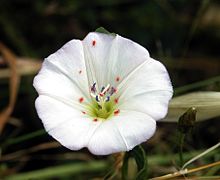Convolvulus arvensis
| Convolvulus arvensis | |
|---|---|

| |
| Scientific classification | |
| Kingdom: | |
| Division: | |
| Class: | |
| Order: | |
| Family: | |
| Genus: | |
| Species: | C. arvensis
|
| Binomial name | |
| Convolvulus arvensis | |
Convolvulus arvensis (Field Bindweed) is a species of bindweed, native to Europe and Asia. It is a climbing or creeping herbaceous perennial plant growing to 0.5-2 m high. The leaves are spirally arranged, linear to arrowhead-shaped, 2-5 cm long, with a 1-3 cm petiole. The flowers are trumpet-shaped, 1-2.5 cm diameter, white or pale pink, with five slightly darker pink radial stripes.

There are two varieties:
- Convolvulus arvensis var. arvensis. Leaves broader.
- Convolvulus arvensis var. linearifolius. Leaves narrower.
Although it produces attractive flowers, it is often unwelcome in gardens as a nuisance weed due to its rapid growth and choking of cultivated plants. It has been introduced to North America, where it is an invasive species in some areas. Its dense mats invade agricultural fields and reduce crop yields; it is estimated that crop losses due to this plant in the United States exceeded US$377 million in the year 1998 alone. [1]
Other common names, mostly obsolete, include lesser bindweed, European bindweed, withy wind (in basket willow crops), perennial morning glory, smallflowered morning glory, creeping jenny, and possession vine. It is called leli in Punjabi.
In one of the tales collected by Jacob and Wilhelm Grimm, Our Lady's Little Glass, this flower is used by Our Lady to drink wine with when she helps free a wagoner's cart. The story goes on to say that "the little flower is still always called Our Lady's Little Glass."
References
- ^ Coombs, E. M., et al., Eds. (2004). Biological Control of Invasive Plants in the United States. Corvallis: Oregon State University Press, 151.
- Blanchan, Neltje (2002). Wild Flowers: An Aid to Knowledge of Our Wild Flowers and Their Insect Visitors. Project Gutenberg Literary Archive Foundation.
{{cite book}}: Check date values in:|year=(help); External link in|title= - Flora Europaea: Convolvulus arvensis
- Flora of China: Convolvulus arvensis
